Exam Details
Exam Code
:JN0-682Exam Name
:Data Center, Professional (JNCIP-DC)Certification
:Juniper CertificationsVendor
:JuniperTotal Questions
:130 Q&AsLast Updated
:Jul 29, 2025
Juniper Juniper Certifications JN0-682 Questions & Answers
-
Question 111:
What are two streaming data formats supported for network analytics? (Choose two.)
A. GPB
B. XML
C. JSON
D. SLAX
-
Question 112:
Referring to the exhibit,
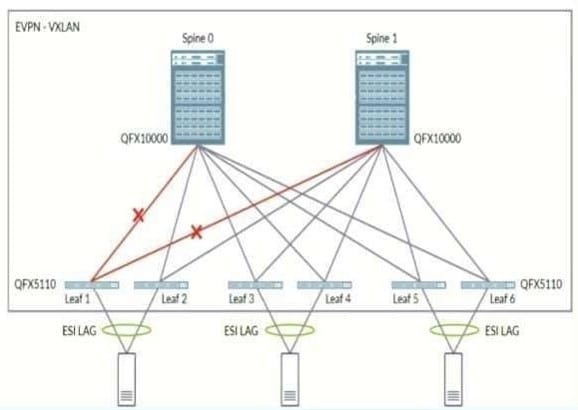
what effect does EVPN core isolation have?
A. Leaf 1 will send a pause frame to each connected host.
B. Leaf 1 will place the interfaces to connected hosts into LACP passive mode.
C. Leaf 1 will take down all revenue interfaces.
D. Spine 1 will block all traffic.
-
Question 113:
You are troubleshooting a traditional Clos Layer 3 IP fabric in your data center. You are reviewing the BGP configuration for one of your spine devices.
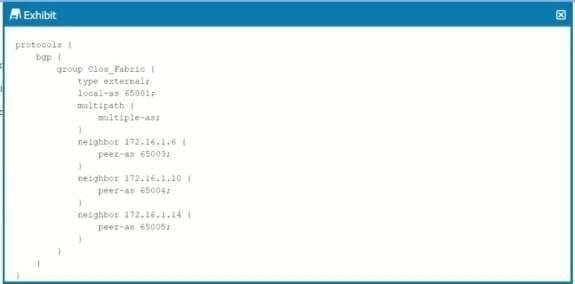
Referring to the exhibit, which statement is correct?
A. This spine device will not install multiple next hops for remote destinations in its routing table.
B. This spine device will not install any routes for remote destinations in its routing table.
C. This spine device has three neighboring leaf devices.
D. This spine device has three neighboring spine devices.
-
Question 114:
You are building an IP fabric underlay network for your new data center. You must ensure that you have predictable load-balancing behavior throughout your network. According to Juniper Networks, what are two best practices that should be followed in this scenario? (Choose two.)
A. All leaf devices must be identical to the spine device models including the same installed line cards.
B. All spine devices should be identical models including the same installed line cards.
C. Every leaf device should have an identical uplink to every other leaf device.
D. Every leaf device should have an identical uplink to every spine device.
-
Question 115:
A client with five data centers spread around the country uses MPLS L2VPNs to provides point- to- point data center interconnect between each data center in a full-mesh network. The client Is considering an MPLS EVEN implementation.
In this scenario, what are three advantages of using MPL5 EVEN interconnects? (Choose two.)
A. The provide for static configuration that does not require a Dynamic Routing Protocol
B. They provide for a local proxy ARP/ND resolution.
C. They provide for point to multipoint connectivity
D. They provide for a MAC learning in the control plane.
E. They provide for lower transmission latency.
-
Question 116:
You are configuring VXLAN. and you must ensure that all switches for the multicast groups advertise their existence and learn about other VTEPs In this scenario. which protocol will accomplish this task?
A. OSPF
B. EVPN
C. PIM
D. BOP
-
Question 117:
You are an architect for an enterprise organization that currently operates three data centers with plans to expand to five data centers in the next year. You already notice large amounts of BUM flooding and must control this issue before implementing the next two data centers.
Which feature would address this issue?
A. type-5 routes
B. type-6 routes
C. mesh groups
D. VXLAN BUM traffic filter
-
Question 118:
You have deployed a multitenant EVPN-VXLAN fabric. You must have the routes in the BLUE VRF show up in the RED VRF. In this scenario, how would you achieve this goal?
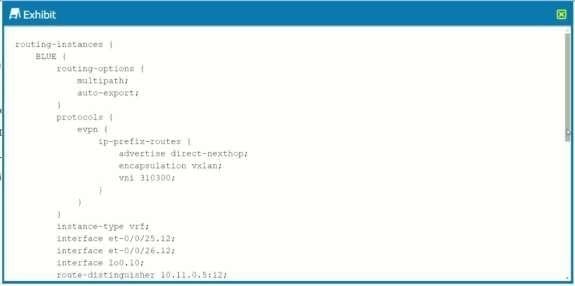
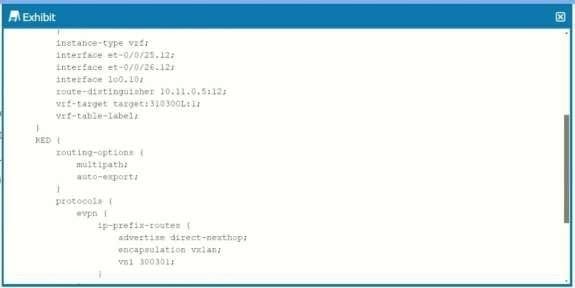

A. Configure a VRF export policy on the BLUE VRF that matches the RED VRF route target.
B. Configure the RED route target in the BLUE VRF.
C. Configure the BLUE route target in the RED VRF.
D. Configure a VRF import policy on the RED VRF that matches the BLUE VRF route target.
-
Question 119:
You are considering deploying a MAC-VRF type routing instance with a VLAN-bundle service type. In this scenario, which two statements are correct? (Choose two.)
A. It can be implemented in a bridge overlay architecture.
B. VLAN normalization is supported.
C. Multiple VLAN IDs per EVI are supported.
D. It can be implemented in an ERB architecture.
-
Question 120:
You have deployed a VXLAN as shown in the exhibit Leaf1, leaf3, spine1, and spine2 have been configured as VTEPs. Host1 cannot communicate with host2.
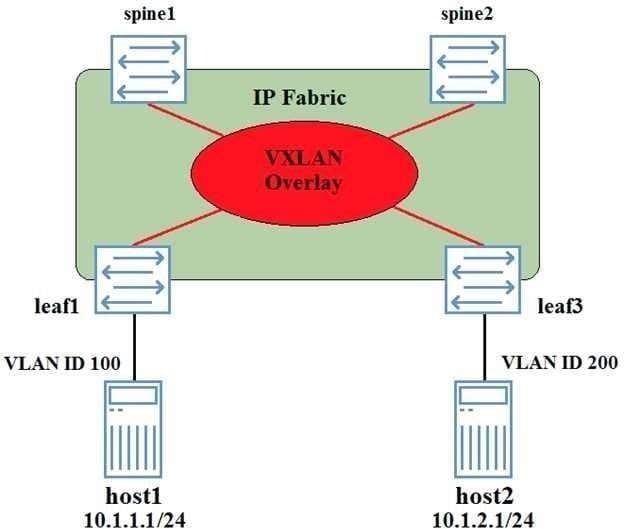
Referring to the exhibit, how would you solve this problem?
A. The VLAN ID on the connected to host2 must be changed to VLAN 100
B. A DCI connected must be created between the VLANs
C. Host1 and host2 must be placed in the same VRF
D. A layer 3 VXLAN gateway must be configured on at least on at least one of the devices
Related Exams:
JN0-102
Internet Associate, Junos(JNCIA-Junos)JN0-104
Junos, Associate (JNCIA-Junos)JN0-105
Junos, Associate (JNCIA-Junos)JN0-1101
Juniper Networks Certified Design Associate (JNCDA)JN0-1103
Design, Associate (JNCIA-Design)JN0-130
Juniper networks Certified internet specialist.e(jncis-e)JN0-1301
Data Center Design, Specialist (JNCDS-DC)JN0-1302
Data Center Design Specialist (JNCDS-DC)JN0-1331
Security Design, Specialist (JNCDS-SEC)JN0-1332
Security Design, Specialist (JNCDS-SEC)
Tips on How to Prepare for the Exams
Nowadays, the certification exams become more and more important and required by more and more enterprises when applying for a job. But how to prepare for the exam effectively? How to prepare for the exam in a short time with less efforts? How to get a ideal result and how to find the most reliable resources? Here on Vcedump.com, you will find all the answers. Vcedump.com provide not only Juniper exam questions, answers and explanations but also complete assistance on your exam preparation and certification application. If you are confused on your JN0-682 exam preparations and Juniper certification application, do not hesitate to visit our Vcedump.com to find your solutions here.